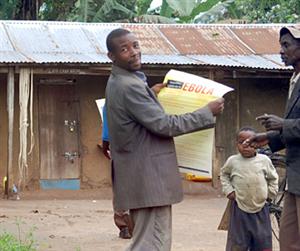Entries in Popular Culture (53)
MetroTV video of suspected Serang bird flu victims
 You know, we don't get to see many breaking television bird flu news stories outside of the US, but Indonesia's MetroTV seems to be doing a good job of broadcasting breaking bird flu news to their viewers. Back in the 1980s, then-news director of Miami's Channel 7, Joel Cheatwood coined the expression "If it bleeds, it leads,"
You know, we don't get to see many breaking television bird flu news stories outside of the US, but Indonesia's MetroTV seems to be doing a good job of broadcasting breaking bird flu news to their viewers. Back in the 1980s, then-news director of Miami's Channel 7, Joel Cheatwood coined the expression "If it bleeds, it leads,"
The MetroTV mantra must be "If they sneeze, they lead." Sorry.
Anyway, if you click on this link, you will see the news story of the family being transported to Jakarta via ambulance. Again, a top of the cap to Commonground, veteran flusite poster. Now I want you to put yourself in the position of any Indonesian resident who is watching this unfold on television. How would you feel if this was broadcast in New York, or Peoria, or Billings, Vancouver, or Tampa? Or Tallahassee?
As Count Floyd used to say: Pretty scary, kids.
Texas-sized MRSA problem with prep football turf
 An excellent article via Bloomberg.com is circulating today. It describes the growing problem the state of Texas is having with MRSA, particularly in its prep football stadiums.
An excellent article via Bloomberg.com is circulating today. It describes the growing problem the state of Texas is having with MRSA, particularly in its prep football stadiums.
Texas loves its high school football arguably better than any other state in the Union. Many high school stadiums are fancier, better-equipped and have a seating capacity larger than many Division 1 college counterparts. It is not uncommon to see a Jumbotron in some stadiums, along with skyboxes and -- artificial turf.
In earlier blogs (search keyword MRSA), I have mentioned the problems indoor stadiums have containing this deadly bacteria. Recall that the NFL's St. Louis Rams had to disinfect all their playing and solid surfaces awhile back, because they were a MRSA Petri dish and were also passing the pathogen to opposing players.
But now the problem is moving outside. Some snippets from the Bloomberg story:
Texas has artificial turf at 18 percent of its high school football stadiums, according to Web site Texasbob.com. It also has an MRSA infection rate among players that is 16 times higher than the estimated national average, according to three studies by the Texas Department of State Health Services.
``This is a disease that can kill you,'' said Carolina Espinoza, a graduate epidemiology student at the University of Texas in Houston, who helped conduct one of the studies. ``If I were a football player, I would be alarmed.''
At least 276 football players were infected with MRSA from 2003 through 2005, a rate of 517 for each 100,000, according to the Texas studies. The U.S. Centers for Disease Control and Prevention in Atlanta reports a rate for the general population of 32 in 100,000.
Football players often become infected at the site of a turf burn and are misdiagnosed, said David Smith, co-author of a study showing that MRSA-related hospitalizations in the U.S. more than doubled from 1999 to 2005.
``The turf burns themselves are just the kind of minor skin injury that MRSA can exploit,'' said Elliot Pellman, medical liaison for the National Football League, which also has had infections among its players.
Football dominates high school sports in Texas, which has more participants than any other state. Seventy-four schools have stadiums seating more than 10,000. The sport provides 22,041 full-time jobs and generates $2.88 billion in annual spending, said Ray Perryman, president of Perryman Group, a Waco economic and financial analysis firm.
MRSA causes more deaths than any of the 51 infectious diseases tracked by the CDC, including AIDS, according to CDC data. The agency doesn't require medical professionals to report MRSA cases.
Texas plans a pilot program next year making MRSA a reportable illness in three regions, said Bryan Alsip, assistant health director for San Antonio.
http://www.bloomberg.com/apps/news?pid=newsarchive&sid=alxhrJDn.cdc
As you know from reading my bio, I am heavily involved in high school football here in Florida and specifically at (Tallahassee) Lincoln High School, where NFL Pro Bowler Antonio Cromartie (yes, THAT Antonio Cromartie), Pat Watkins, Pro Bowler and Super Bowl ring-holder Kevin Carter, Craphonso Thorpe and other current or former NFL players and a massive list of college alumni played. Or, more specifically, where all the local high schools play football. the teams play on natural grass, which is not immune to MRSA either.
Regrettably, in the third-largest state in the Union, Florida's governing high school sports organization is apparently either unaware of or is downplaying the nation's growing concern with MRSA. The Florida High School Athletic Association's Website, www.fhsaa.org, only contains three references to MRSA, and two of them are within minutes of 2004 committee meetings. A third reference is a link to a National Federation of High School Associations 4-page paper on MRSA. None are on the main page, and are instead buried deep within the site.
Big deal.
Last year and with much fanfare, the State of Florida instituted mandatory steroids testing for its student-athletes. That is symbolically important, and maybe they'll even catch an athlete or two. But in an area that matters much more, and affects far, far, far more students in and out of athletics -- namely, the prevention and mitigation of a potentially deadly staph infection that footballers, wrestlers and weightlifters are especially susceptible to, but any student can catch -- the State's high school athletic association is absolutely mute.
I am sure this is not limited to Florida; how does your state stack up on the issue?
Ask your coach. If s/he doesn't know the acronym "MRSA," you have your answer.
Shakespeare in Pakistan
 Make yourself comfortable, as this blog is unusually long -- even by my standards
Make yourself comfortable, as this blog is unusually long -- even by my standards
The first World Health Organization team is on the ground and working in Peshawar province in northwest Pakistan. And barely within hours of the arrival of the advance team, declarations were made and assurances were given that things were not as bad as first thought.
But Shakespeare also deplaned in Pakistan, accompanying the WHO team to the microphones. First, the stories on the arrival of the WHO. This is from Pakistani newspaper The News:
| WHO team visits families of bird flu victims |
 |
 |
 |
| By Mushtaq Yusufzai 12/19/2007 |
PESHAWAR: A team of the World Health Organisation experts on Tuesday visited the NWFP where they visited the Khyber Teaching Hospital and also met the ill-fated family of two young students who died of bird flu virus in October.
Also, a WHO technical team is also arriving Pakistan today (Wednesday) which, according to sources, would verify the results of bird flu victims diagnosed by the NIH Islamabad.
After their arrival, the WHO officials held talks with senior officials of the NWFP health department who told them of the situation in the province created after the bird flu virus.They went to the Khyber Teaching Hospital (KTH) where the two young brothers, Muhammad Idrees and Muhammad Ilyas, died on October 19 and 29 respectively mainly because of sheer negligence of the hospital administration, the NWFP health department as well as of the National Institute of Health (NIH), Islamabad.
In KTH, the WHO team arranged an informative workshop for doctors and nurses of the hospital, especially those dealing with bird flu patients.
Officials in the KTH told 'The News' the WHO team had brought Personal Protection Equipment (PPE) for the staff of the hospital.
The team also visited isolation rooms in the hospital where patients suffering from bird flu virus were admitted and advised the hospital administration to select some safe place at a distance from the rest of the hospital for keeping the bird flu victims, so that the virus could not spread in the hospital. It is very painful to mention here that in the entire province, there is not even a single isolation room for infectious diseases.
With the consultation of the WHO team, the KTH administration selected a separate portion in the hospital for keeping bird flu patients. There are 11 isolation rooms in the portion, which would accommodate 22 patients.
Acting Chief Executive KTH, Prof Dr Siddiqur Rahman, nominated Dr Mukhtiar Zaman Afridi as the head of a team that would handle bird flu related cases.
The WHO officials praised doctors and health workers of the KTH for their efforts, which the officials felt saved many lives. The team members said in the world so far 60 per cent of the bird flu patients died while the ratio in Pakistan, 35 per cent, was quite encouraging.
The team members later went to Tajabad town in Peshawar and met the family members of two young brothers died of the disease.
Note the October reference to the deaths, which we think was actually November 19 and 29, respectively. But everything is up in the air these days, as we try to figure out if a brother is really a cousin, etc. So let's stay loose on relatives, and dates of death for the time being.
Note the October reference to the deaths, which we think was actually November 19 and 29, respectively. But everything is up in the air these days, as we try to figure out if a brother is really a cousin, etc. So let's stay loose on relatives, and dates of death for the time being.Now a second report on the activity in the region, this time from Indian newspaper The Hindu. All bolding is mine.
Experts comb Pak. for signs of human-to-human bird flu infection
ISLAMABAD, Pakistan (AP): A second team of health experts arrived in Pakistan on Wednesday to analyze samples from suspected bird flu cases to determine how the virus spread and whether human-to-human transmission may have occurred.
The experts from the US Naval Medical Research Unit No. 3 were expected to retest samples already gathered from a number of patients who were positive for the H5N1 bird flu virus in initial government analysis. Once the cases are confirmed, work will begin to piece together how the victims became infected.
"They are now investigating," said Orya Maqbool Jan Abbasi, spokesman for Pakistan's Health Ministry. ``The next day or two is very important.''
Four brothers were sickened last month in Abbotabad, north of Islamabad. Two died, one of whom was buried before tests were conducted. The other three tested positive for the virus. Up to six more people were suspected of being infected, including several who were in contact with poultry.
Outbreaks were reported among birds in the area before the human cases. However, Abassi stressed that there have been no new reports of bird flu in poultry or people.
A separate WHO team visited a hospital Tuesday in the northwestern city Peshawar that treated some of the patients. They were working with doctors and nurses on how to handle suspected cases and improve infection control measures.
``They want to go through the records in the hospital for the last month or two to see if there's been any upsurge in respiratory cases that weren't identified as H5N1 but which could actually be,'' said Gregory Hartl, a WHO spokesman in Geneva.
The team will look to see which patients could have been exposed to the virus by infected birds and also whether human-to-human transmission could have occurred.
One of the brothers who survived, Mohammed Ishtiaq, said he was hospitalized with flu symptoms after slaughtering chickens suspected of carrying bird flu without wearing protective clothing last month.
His brothers who died visited him in a hospital, he said.
Hartl said no new cases have been discovered, but increased awareness has led to more people with flu-like symptoms being checked.
``What this is showing is that they're taking everything very, very seriously,'' Hartl said. ``Surveillance has been enhanced, more people are reporting cases and more people have been sensitized on the heath care worker side of the need to notice.''
Pakistan has requested additional supplies of the antiviral Tamiflu as a precaution, Hartl said.
At least 209 people have died worldwide from the virus, which began plaguing Asian poultry stocks in late 2003, according to the WHO. It remains hard for people to catch, but scientists worry it could mutate into a form that spreads easily among people, potentially sparking a pandemic.
Associated Press medical writer, Margie Mason, contributed to this report from Hanoi, Vietnam.
But wait, according to WHO influenza head Dr. Keiji Fukuda, there is nothing extraordinary going on in Pakistan. This story is from Reuters, dateline Islamabad (as was the above AP story), so we know for sure we have Mainstream Journalist Boots On the Ground! I am bolding all Fukuda quotes and references.
WHO probes Pakistan's first bird flu death
By Augustine AnthonyTue Dec 18, 2:25 PM ET
Pakistani authorities and World Health Organisation experts were trying to determine on Tuesday whether bird flu had passed from human to human after the country reported its first human death from the virus.
But Pakistani and World Health Organisation (WHO) officials said there was no immediate cause for alarm and the United Nations agency was not raising its level of pandemic alert for the time being.
Pakistani health officials confirmed at the weekend that eight people had tested positive for the H5N1 bird flu virus in North West Frontier Province since late October, and one of the confirmed cases had died.
A brother of the dead man, who had not been tested, also died. It was not yet clear if he was a victim of bird flu.
Ministry of Health spokesman Orya Maqbool Jan Abbasi said the first man to catch avian influenza had been working culling poultry. He recovered but his brothers died.
Abbasi and other health officials said there was no suggestion of human to human transmission.
"Absolutely not," said Health Secretary Khushnood Akhtar Lashari. "The WHO is looking into all the things but whatever we have at the moment there's nothing to suggest that, remotely."
 The global coordinator of WHO's influenza program, Keiji Fukuda, also said the eight cases are likely a combination of infections from poultry and limited person to person transmission due to close contact.
The global coordinator of WHO's influenza program, Keiji Fukuda, also said the eight cases are likely a combination of infections from poultry and limited person to person transmission due to close contact.
Fukuda said while unconfirmed, any human to human spread seemed similar to previous outbreaks in Thailand and Indonesia -- affecting close family members caring for sick loved ones, adding it was very reassuring that "we are not seeing large increases in the number of cases."
"It is definitely possible that we have a mixed scenario where we have poultry to human infection and possible human to human transmission within a family, which is not yet verified," he told Reuters in an interview.
Humans rarely contract H5N1, which is mainly an animal disease. Experts fear the strain could spark a global pandemic and kill millions if it mutates to a form that spreads more easily.
SECOND WHO TEAM
Lashari said the man who had been culling poultry might have inadvertently brought the virus back to his home, where his brothers fell sick.
"He took his equipment along and the suspicion is the virus was in the equipment he was carrying," Lashari said. "These are conjectures. It will be established when they do the sequencing test of the virus."
The area of the outbreak, near the towns of Mansehra and Abbottabad, about 60 km (40 miles) north of the capital, Islamabad, is in the foothills of the Himalayas. Partly forested slopes are dotted with villages and small chicken farms.
Abasi said 100 people with symptoms of flu living in the vicinity had been checked but all tested negative.
The last human case was reported on November 23, he said.
Of the seven people confirmed to be sick with avian influenza, six had recovered while one was being treated, a provincial health official said.
A three-member WHO team, joined by officials from the Pakistan National Institute of Health, traveled on Monday to Peshawar, the province's capital where the patients were treated. A second WHO team was due to arrive on Wednesday.
Authorities reported the last H5N1 virus case in wild birds in the area on November 30.
Bird flu first appeared in Pakistan in early 2006, and several outbreaks of H5N1 were reported this year.
The Pakistani cases bring to nearly 350 the number of people worldwide who are known to have contracted the H5N1 virus, which has killed more than 200 people since 2003.
(Additional reporting by Robert Birsel in Islamabad and Stephanie Nebehay in Geneva; Editing by Sami Aboudi)
Dr. Fukuda is a very well-respected doctor. He is also with the WHO/UN, which means he is also a diplomat. So parsing words is a unique talent; so is deciphering them. Another Fukuda reference comes today from Reuters:
Mixed scenario seen behind Pakistan birdflu spread
By Stephanie NebehayTue Dec 18, 5:29 PM ET
The eight individuals in Pakistan who are suspected to have bird flu probably have a combination of infections from poultry and limited person-to-person transmission from close contact, a top World Health Organization expert said on Tuesday. Keiji Fukuda, coordinator of WHO's global influenza program, said while unconfirmed, any human-to-human spread seemed similar to previous outbreaks in Thailand and Indonesia -- affecting close family members caring for sick loved ones.
There was no immediate cause for alarm and the United Nations agency was not raising its level of pandemic alert for the time being, he said, adding it was very reassuring that "we are not seeing large increases in the number of cases."
"Right now it doesn't look like pure human to human transmission. It looks like the veterinarian, who was the index case, and a number of other suspect cases had poultry exposure," Fukuda told Reuters in an interview.
"It is definitely possible that we have a mixed scenario where we have poultry to human infection and possible human to human transmission within a family, which is not yet verified."
But human to human transmission "would not be particularly surprising or unprecedented," he added.
Eight people have tested positive for the H5N1 bird flu virus in North West Frontier Province since late October, and one of the confirmed cases has died. A brother of the dead man also died, but was never tested, so is not counted among them.
H5N1 is mainly an animal disease, but experts fear it could mutate into a form that could spread easily between people, causing a pandemic which could kill millions of people. In Thailand, a mother was killed by the virus in 2004 after cradling her dying infected daughter all night. The largest known cluster of human bird flu cases worldwide occurred in May 2006 in Indonesia's North Sumatra province, where as many as seven people in an extended family died.
Three WHO experts, led by Hassan El-Bushra of its regional Cairo office, is in Pakistan helping to investigate the outbreak.
The "index" case, who recovered, is a veterinarian who helped with culling operations and it is his two brothers who died after taking care of the ill man, according to Fukuda.
"This type of close contact we know can result in human to human transmission sometimes," he said.
"Right now, based on the information we have, the investigation going on and the feedback from the field team, we don't have anything pointing to push the alarm bells or increase the (pandemic alert) phase," he added.
The WHO uses a series of six phases of pandemic alert to gauge the level of threat. The world is currently in phase 3, a new influenza virus subtype is causing disease in humans, but is not yet spreading efficiently or sustainable among humans.
"In terms of public health implications, we are looking for human to human transmission where casual contact can lead to infections and allow big outbreaks in communities," Fukuda said.
A team from the U.S. Naval Medical Research Unit NAMRU-3 laboratory in Cairo was expected in Pakistan on Wednesday to carry out further tests on the samples from the suspect cases.
Gee, wonder where he got that "pushing the button" reference? Or the need to reassure the planet that this is no reason to go to Phase Four?
There are three possible reasons:
1. Dr. Fukuda reads this blog. Highly unlikely.
2. The mainstream media reads this blog, along with other blogs and Flusites such as FluTrackers and Flu Wiki. They decided to probe the question of Phase Four based on reading blogs and flusites. Or the media Googled the beejeesus out of the issue and found all the references. Possible, even likely.
3. The WHO is "leaning forward" on the issue of when to actually raise the threat level, and Dr. Fukuda was speaking what everyone in Geneva was thinking. In other words, Dr. Fukuda, Dr. Margaret Chan and global influenza experts were thinking the exact same thing we were: Is this the appropriate time to Push The Button?
This is the Most Likely Scenario, in my opinion.
I want to zoom in on what Dr. Fukuda said as a guide for when we can expect Phase Four to be enacted. Again, from the news story above:
So, back to the bard. Why did he deplane in Pakistan? The answer is complex yet simple. Pakistan is wrestling with potential civil war, terrorism a la al Qaida and its leader Osama bin Laden (who may or may not be hiding in the same geographic region where all the flu stuff is taking place), huge public demonstrations and percolating civil unrest, and there is always that nuclear thing with India. And as we all know, yesterday in southern Pakistan a train accident killed nearly 50 people.
 So a nation with a shaky government and warring factions and a hostile neighbor and the world's Public Enemy #1 hiding within its borders -- well, they kind of need some good news for a change. Good News would be defined in this context as the absence of really bad news. And as we are seeing in the entire nation right now, there is High Anxiety among its people. What if the WHO actually came out and said sustained H2H happened? It is not inconceivable that Pakistan could reach the Tipping Point. In global terms, that would be a really, really bad thing.
So a nation with a shaky government and warring factions and a hostile neighbor and the world's Public Enemy #1 hiding within its borders -- well, they kind of need some good news for a change. Good News would be defined in this context as the absence of really bad news. And as we are seeing in the entire nation right now, there is High Anxiety among its people. What if the WHO actually came out and said sustained H2H happened? It is not inconceivable that Pakistan could reach the Tipping Point. In global terms, that would be a really, really bad thing.
You have probably already guessed the Shakespeare line I am referring to. It is from Hamlet. Hamlet turns to Queen Gertrude and says,
"Madam, how do you like this play?"
Queen Gertrude replies, "The lady protests too much, methinks."
Let's just hope Hamlet's response is from the WHO's mouth to the world's ears:
Newsweek article suggests cover-up of Ebola infection in Uganda
 Newsweek magazine has weighed in on the escalating/deteriorating situation in Uganda. And if you read the article carefully, and match Newsweek's suspected case total with the official records, you get a wildly divergent -- and extremely unsettling -- new number of potentially infected persons. Not to mention the possibility of a deliberate cover-up of the virus by government officials.
Newsweek magazine has weighed in on the escalating/deteriorating situation in Uganda. And if you read the article carefully, and match Newsweek's suspected case total with the official records, you get a wildly divergent -- and extremely unsettling -- new number of potentially infected persons. Not to mention the possibility of a deliberate cover-up of the virus by government officials.
The article itself is a good digest of what has already happened. And as we know and is proven by the presence of a reporter in the village -- Newsweek's Andrew Ehrenkranz (photo) -- there is no substitute for Journalist Boots on the Ground. As admirable a job as as the Myhres' have done to update their blog, they are not journalists, aimed at extracting the truth.
The paragraph in question is this one:
Some Ugandans, however, are questioning whether Museveni's government deliberately covered up news of the outbreak ahead of the recent meeting of the Commonwealth Heads of Government meeting in the capital city, Kampala. The government did not announce the outbreak until just after the conclusion of the high-profile meeting, even though government reports acknowledge that blood samples from infected patients were sent to South Africa for Ebola testing on Sept. 29. These samples were reportedly found negative for Ebola but were subsequently shown to carry a new strain of the virus at the Centers for Disease Control (CDC) in Atlanta on Nov. 24—the second day of the Commonwealth meeting. The initial false negative may have been due to the difficulties of identifying the new strain—even the CDC tests took a day longer than usual—but that hasn't stopped public outrage over whether the government could have acted faster to stop the spread of the virus. "It looks quite strange, from a public health perspective, that blood samples were not taken [to the CDC] earlier," said Dr. George Pariyo, dean of the public health school at Kampala's well-respected Makerere University in a front-page Uganda Monitor feature investigating the suggestions of a government cover-up.
Other news regarding the actual number of infected, plus the prospect of large numbers of "super-spreaders" of the disease, are also mentioned by Newsweek:
Bundibugyo is at the epicenter of the outbreak, which began in August. Doctors in the town are monitoring more than 360 sick people believed to be incubating the virus and have recorded 18 local fatalities, including four medical staffers at Bundibugyo Hospital. Townspeople are terrified by the outbreak. Bundibugyo's usually bustling central market is quiet, and residents of nearby villages are anxiously reading newly distributed Ebola information posters. Hawkers sell the antibiotic Cipro at inflated prices on the street, falsely promising that it can prevent infection; local healers and herbalists are offering their own versions of a cure. (bold mine)
The piece continues:
But while the new strain seems to be less virulent, it also raises the possibility that the infected are now more likely to survive long enough to spread it elsewhere. Already there have been Ebola cases in eight districts across Uganda, with confirmed cases as far away as Mbale, a village some 600 miles from the outbreak zone. On Uganda's borders, neighboring Kenya, Rwanda, Tanzania, and Sudan are screening all Ugandans for symptoms and travel patterns in an attempt to halt the disease from spreading into their countries.
Let's hope the global media keeps its focus on this growing problem in Eastern Africa. The entire story can be found at:
Why telecommuting will probably fail in a pandemic, Vol. 1
 Has anyone noticed their Internet connection slowing down over the past few days?
Has anyone noticed their Internet connection slowing down over the past few days?
Has anyone not noticed the slowness of the Internet, especially at night?
E-commerce retailers are experiencing a huge surge in shoppers this holiday season. And nowhere is this more evident than in the (in)ability of users to expeditiously shop on their favorite Websites this holiday season. I can speak directly to this issue. For example, while shopping for a new television set online, I was thrown off Sears.com several times, and thrown off circuitcity.com almost as many times. Screen refreshes were agonizingly slow, and I would up shutting off the computer and waiting for a more suitable time to shop.
Welcome to the New Normal on the Internet once a pandemic starts. As we have discussed before, the New Normal (at least for 8 to 12 weeks at a time) will be socially-distanced parents attempting to work from home, while their kids are toiling away on their XBox 360s hooked up to the net, gaming with 200,000 of their closest online friends. The cumulative effect of this will be to slow even the highest-speed cable connection to a veritable crawl.
But even a pandemic may not be the trigger to bring the Web to its knees. A recent USA Today article speaks of the dangers to bandwidth that are just a few years off, even without the threat of a looming pandemic. Here it is:
Video, interactivity could nab Web users by '10
NEW YORK — Enjoy your speedy broadband Web access while you can.
The Web will start to seem pokey as early as 2010, as use of interactive and video-intensive services overwhelms local cable, phone and wireless Internet providers, a study by business technology analysts Nemertes Research has found.
"Users will experience a slow, subtle degradation, so it's back to the bad old days of dial-up," says Nemertes President Johna Till Johnson. "The cool stuff that you'll want to do will be such a pain in the rear that you won't do it."
Nemertes says that its study is the first to project traffic growth and compare it with plans to increase capacity.
The findings were embraced by the Internet Innovation Alliance (IIA), a tech industry and public interest coalition that advocates tax and spending policies that favor investments in Web capacity.
The findings were embraced by the Internet Innovation Alliance (IIA), a tech industry and public interest coalition that advocates tax and spending policies that favor investments in Web capacity.
"We're not trying to play Paul Revere and say that the Internet's going to fall," says IIA co-Chairman Larry Irving. "If we make the investments we need, then people will have the Internet experience that they want and deserve."
Nemertes says that the bottleneck will be where Internet traffic goes to the home from cable companies' coaxial cable lines and the copper wires that phone companies use for DSL.
Cable and phone companies provide broadband to 60.2 million homes, accounting for about 94% of the market, according to Leichtman Research Group.
To avoid a slowdown, these companies, and increasingly, wireless services providers in North America, must invest up to $55 billion, Nemertes says. That's almost 70% more than planned.
Much of that is needed for costly running of new high-capacity lines. Verizon is replacing copper lines with fiber optic for its FiOS service, which has 1.3 million Internet subscribers.
Johnson says that cable operators, with 32.6 million broadband customers, also must upgrade. Most of their Internet resources now are devoted to sending data to users — not users sending data. They'll need more capacity for the latter as more people transmit homemade music, photos and videos.
"Two years ago, nobody knew what YouTube was," Johnson says. "Now, it's generating 27 petabytes (27 million gigabytes) of data per month."
Schools, hospitals and businesses could add to the flood as they use the Web for long-distance education, health care services and videoconferencing.
Service providers might not appreciate how fast Web demand is growing, Johnson says: "Comcast doesn't know what's going on in AT&T's network, and vice versa. Researchers are increasingly shut out. So nobody's getting good, global knowledge about the Internet."
One of the best-kept secrets in netland is the existence of LambdaRail, an educational network that makes broadband seem as slow as dialup. First, some history: What we know today as the Internet was actually built by the US military during the Cold War. It was a data communications network called ARPANET; a network so resilient that it could survive multiple nuclear strikes. After the US military surrendered ARPANET to Higher Education, the colleges and universities turned it into what we know today as the Internet (sorry, Al, you didn't do a damn thing to build it). And then the planet took the Internet over from academia.
Academia never really got over that idea, so they built their own, faster, better net, called LambdaRail. It travels orders of magnitude faster than the public Internet does. And it has relatively few users; so few, in fact, that state university systems are now trying to resell LambdaRail bandwidth to anyone who technically qualifies (you have to have some serious jack, plus a smidgen of an educational purpose, so most need not even bother to apply). In my day job, I am seriously considering moving my organization to LR as a way to fuse our disaster recovery network planning with our daily net business model. If we move to LR, we hypothetically should avoid the wobbles, crunches and squeezes the rest of you peons will face when the pandemic arrives. HAHAHAHAAAAAAA!
Anyway, this LR stuff may all sound good, but the impact of a pandemic to global commerce, globalization itself, and the just-in-time economy will be sudden and devastating. The same Internet that carries your Flikr photos and YouTube videos also carries banking information, billions and billions of transactions, and literally trillions of dollars move on it annually. So the idea that during a pandemic, Johnny's game of Assassin's Creed for the 360, coupled with Mom's need to log in and hit the corporate mainframe via a Web portal cumulatively causing a global financial meltdown is more than just the stuff of fiction.
Booz Allen Hamilton came to this conclusion last June, when they predicted the Internet would collapse in the EU in Day Four of a severe pandemic. So the lesson is to watch the Internet this holiday season, study how it slows down, then envision this scenario being the New Normal during a pandemic. Or anytime in 2010, according to Gannett.
Happy shopping.
